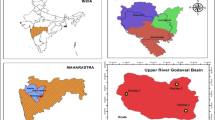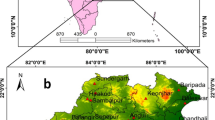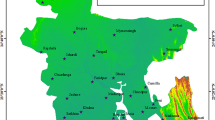Abstract
Agricultural droughts are a prime concern for economies worldwide as they negatively impact the productivity of rain-fed crops, employment, and income per capita. In this study, Standard Precipitation Index (SPI) has been used to evaluate different drought indices for Rajasthan of India. In agricultural, hydrological, and meteorological applications such as irrigation scheduling, crop simulation, water budgeting, reservoir operations, and weather forecasting, the accurate estimation of the drought indices such as the Standardized Precipitation Index (SPI) plays an important role. Thus, the present study was conducted to examine the feasibility and effectiveness of the Random Subspace (RSS) model and its hybridization with the M5 Pruning tree (M5P), Random Forest (RF), and Random Tree (RT) to estimate the SPI at 3, 6, and 12 droughts during 2000–2019. Performances of RSS and hybridized algorithms were assessed and compared using performance indicators (i.e., MAE, RMSE, RAE, RRSE, and R2) and various graphical interpretations. Results indicated that the RSS-M5P provided the most accurate SPI prediction (MAE = 0.497, RMSE = 0.682, RAE = 81.88, RRSE = 87.22, and R2 = 0.507 for SPI-3; MAE = 0.452, RMSE = 0.717, RAE = 69.76, RRSE = 85.24, and R2 = 0.402 for SPI-6. And MAE = 0.294, RMSE = 0.377, RAE = 55.79, RRSE = 59.57, and R2 = 0.783 for SPI-12) compare to RSS alone, RSS-RF, and RSS-RT models for study the drought situation in Jaisalmer Rajasthan. The M5P algorithms have improved the performance of the RSS structure.








Similar content being viewed by others
Availability of data and materials
Not applicable.
Code availability
Not applicable.
Abbreviations
- SPI:
-
Standard Precipitation Index
- RSS:
-
Random Subspace
- M5P:
-
M5 Pruning tree
- RF:
-
Random Forest
- RT:
-
Random Tree
- MAE:
-
Mean absolute error
- RMSE:
-
Root mean square error
- RAE:
-
Relative absolute error
- RRSE:
-
Root relative squared error
- R2 :
-
Coefficient of determination
- P:
-
Precipitation
- PET:
-
Potential evapotranspiration
- °C:
-
Degree celsius
- mm:
-
Millimetre
- DrinC:
-
Drought Indices Calculator
- SDR:
-
Standard deviation reduction factor
- SE:
-
Standard error
- ML:
-
Machine learning
- MPMR:
-
Minimum probability machine regression
- ELM:
-
Extreme learning machine
- OSELM:
-
Online sequential-ELM
- ANNs:
-
Artificial neural networks
- SVR:
-
Support vector regression
- WA-ANN:
-
Coupled wavelet-anns
- MLP:
-
Multilayer perceptron
- MLP-ICA:
-
Imperialistic Competitive Algorithm-MLP
- MSPI:
-
Multivariate Standardized Precipitation Index
References
Abd-Elaty I, Kushwaha NL, Grismer ME et al (2022a) Cost-effective management measures for coastal aquifers affected by saltwater intrusion and climate change. Sci Total Environ 836:155656. https://doi.org/10.1016/j.scitotenv.2022.155656
Abd-Elaty I, Shoshah H, Zeleňáková M et al (2022b) Forecasting of flash floods peak flow for environmental hazards and water harvesting in desert area of El-Qaa Plain, Sinai. Int J Environ Res Public Health 19:6049. https://doi.org/10.3390/ijerph19106049
Aghelpour P, Varshavian V (2021) Forecasting different types of droughts simultaneously using multivariate standardized precipitation index (MSPI), MLP neural network, and imperialistic competitive algorithm (ICA). Complexity 2021:e6610228. https://doi.org/10.1155/2021/6610228
Ali M, Deo RC, Maraseni T, Downs NJ (2019) Improving SPI-derived drought forecasts incorporating synoptic-scale climate indices in multi-phase multivariate empirical mode decomposition model hybridized with simulated annealing and kernel ridge regression algorithms. J Hydrol 576:164–184. https://doi.org/10.1016/j.jhydrol.2019.06.032
Alizamir M, Kisi O, Muhammad Adnan R, Kuriqi A (2020) Modelling reference evapotranspiration by combining neuro-fuzzy and evolutionary strategies. Acta Geophys 68:1113–1126. https://doi.org/10.1007/s11600-020-00446-9
Anand J, Gosain AK, Khosa R, Srinivasan R (2018) Regional scale hydrologic modeling for prediction of water balance, analysis of trends in streamflow and variations in streamflow: the case study of the Ganga River basin. J Hydrol Reg Stud 16:32–53. https://doi.org/10.1016/j.ejrh.2018.02.007
Behnood A, Behnood V, Modiri Gharehveran M, Alyamac KE (2017) Prediction of the compressive strength of normal and high-performance concretes using M5P model tree algorithm. Constr Build Mater 142:199–207. https://doi.org/10.1016/j.conbuildmat.2017.03.061
Belayneh A, Adamowski J (2013) Drought forecasting using new machine learning methods. J Water Land Dev 18:3–12. https://doi.org/10.2478/jwld-2013
Belayneh A, Adamowski J, Khalil B (2016) Short-term SPI drought forecasting in the Awash River Basin in Ethiopia using wavelet transforms and machine learning methods. Sustain Water Resour Manag 2:87–101. https://doi.org/10.1007/s40899-015-0040-5
Biau G, Scornet E (2015) A random forest guided tour. arXiv:151105741 [math, stat]
Breiman L (2001) Random forests. Mach Learn 45:5–32. https://doi.org/10.1023/A:1010933404324
Chen F, Mitchell K, Schaake J et al (1996) Modeling of land surface evaporation by four schemes and comparison with FIFE observations. J Geophys Res Atmos 101:7251–7268. https://doi.org/10.1029/95JD02165
Ditthakit P, Pinthong S, Salaeh N et al (2021) Using machine learning methods for supporting GR2M model in runoff estimation in an ungauged basin. Sci Rep 11:19955. https://doi.org/10.1038/s41598-021-99164-5
Dong X, Yu Z, Cao W et al (2020) A survey on ensemble learning. Front Comput Sci 14:241–258. https://doi.org/10.1007/s11704-019-8208-z
Elbeltagi A, Aslam MR, Malik A et al (2020) The impact of climate changes on the water footprint of wheat and maize production in the Nile Delta, Egypt. Sci Total Environ 743:140770. https://doi.org/10.1016/j.scitotenv.2020.140770
Elbeltagi A, Aslam MR, Mokhtar A et al (2021) Spatial and temporal variability analysis of green and blue evapotranspiration of wheat in the Egyptian Nile Delta from 1997 to 2017. J Hydrol 594:125662. https://doi.org/10.1016/j.jhydrol.2020.125662
Elbeltagi A, Di Nunno F, Kushwaha NL et al (2022a) River flow rate prediction in the Des Moines watershed (Iowa, USA): a machine learning approach. Stoch Environ Res Risk Assess. https://doi.org/10.1007/s00477-022-02228-9
Elbeltagi A, Kushwaha NL, Rajput J et al (2022b) Modelling daily reference evapotranspiration based on stacking hybridization of ANN with meta-heuristic algorithms under diverse agro-climatic conditions. Stoch Environ Res Risk Assess. https://doi.org/10.1007/s00477-022-02196-0
Healey SP, Cohen WB, Yang Z et al (2018) Mapping forest change using stacked generalization: an ensemble approach. Remote Sens Environ 204:717–728. https://doi.org/10.1016/j.rse.2017.09.029
Ho TK (1998) The random subspace method for constructing decision forests. IEEE Trans Pattern Anal Mach Intell 20:832–844. https://doi.org/10.1109/34.709601
Kalmegh S (2015) Analysis of weka data mining algorithm reptree, simple cart and randomtree for classification of indian news. Int J Innov Sci Eng Technol 2:438–446
Khosravi K, Daggupati P, Alami MT et al (2019) Meteorological data mining and hybrid data-intelligence models for reference evaporation simulation: a case study in Iraq. Comput Electron Agric. https://doi.org/10.1016/j.compag.2019.105041
Kuriqi A, Ali R, Pham QB et al (2020a) Seasonality shift and streamflow flow variability trends in central India. Acta Geophys 68:1461–1475. https://doi.org/10.1007/s11600-020-00475-4
Kuriqi A, Pinheiro AN, Sordo-Ward A, Garrote L (2020b) Water-energy-ecosystem nexus: balancing competing interests at a run-of-river hydropower plant coupling a hydrologic–ecohydraulic approach. Energy Convers Manage 223:113267. https://doi.org/10.1016/j.enconman.2020.113267
Kushwaha NL, Bhardwaj A, Verma VK (2016) Hydrologic response of Takarla-Ballowal watershed in Shivalik foot-hills based on morphometric analysis using remote sensing and GIS. J Indian Water Resour Soc 36:17–25
Kushwaha NL, Rajput J, Elbeltagi A et al (2021) Data intelligence model and meta-heuristic algorithms-based pan evaporation modelling in two different agro-climatic zones: a case study from Northern India. Atmosphere 12:1654. https://doi.org/10.3390/atmos12121654
Kushwaha N, Elbeltagi A, Mehan S et al (2022a) Comparative study on morphometric analysis and RUSLE-based approaches for micro-watershed prioritization using remote sensing and GIS. Arab J Geosci 15:564. https://doi.org/10.1007/s12517-022-09837-2
Kushwaha NL, Rajput J, Shirsath PB et al (2022) Seasonal climate forecasts (SCFs) based risk management strategies: a case study of rainfed rice cultivation in India. J Agrometeorol 24:10–17. https://doi.org/10.54386/jam.v24i1.775
Malik A, Kumar A, Rai P, Kuriqi A (2021) Prediction of multi-scalar standardized precipitation index by using artificial intelligence and regression models. Climate 9:28. https://doi.org/10.3390/cli9020028
Mao J, Fu W, Shi X et al (2015) Disentangling climatic and anthropogenic controls on global terrestrial evapotranspiration trends. Environ Res Lett 10:094008. https://doi.org/10.1088/1748-9326/10/9/094008
McKee T, Doesken N, Kleist J (1993) The relationship of drought frequency and duration to time scales. In: Proceedings of the 8th conference on applied climatology. Anaheim, CA, USA, pp 179–184
Melesse AM, Khosravi K, Tiefenbacher JP et al (2020) River water salinity prediction using hybrid machine learning models. Water 12:2951
Misra S, Li H (2020) Chapter 9—noninvasive fracture characterization based on the classification of sonic wave travel times. In: Misra S, Li H, He J (eds) Machine learning for subsurface characterization. Gulf Professional Publishing, Houston, pp 243–287
Mosavi A, Shirzadi A, Choubin B et al (2020) Towards an ensemble machine learning model of random subspace based functional tree classifier for snow avalanche susceptibility mapping. IEEE Access. https://doi.org/10.1109/ACCESS.2020.3014816
Muhammad Adnan R, Chen Z, Yuan X et al (2020) Reference evapotranspiration modeling using new heuristic methods. Entropy 22:547. https://doi.org/10.3390/e22050547
Nhu V-H, Shahabi H, Nohani E et al (2020) Daily water level prediction of Zrebar Lake (Iran): a comparison between M5P, random forest, random tree and reduced error pruning trees algorithms. ISPRS Int J Geo Inf 9:479. https://doi.org/10.3390/ijgi9080479
Pham BT, Prakash I, Tien Bui D (2018) Spatial prediction of landslides using a hybrid machine learning approach based on random subspace and classification and regression trees. Geomorphology 303:256–270. https://doi.org/10.1016/j.geomorph.2017.12.008
Poornima S, Pushpalatha M (2019) Drought prediction based on SPI and SPEI with varying timescales using LSTM recurrent neural network. Soft Comput 23:8399–8412. https://doi.org/10.1007/s00500-019-04120-1
Quinlan JR (1992) Learning with continuous classes. World Scientific, Singapore, pp 343–348
Rahman M, Chen N, Elbeltagi A et al (2021) Application of stacking hybrid machine learning algorithms in delineating multi-type flooding in Bangladesh. J Environ Manag 295:113086. https://doi.org/10.1016/j.jenvman.2021.113086
Rodell M, Velicogna I, Famiglietti JS (2009) Satellite-based estimates of groundwater depletion in India. Nature 460:999–1002. https://doi.org/10.1038/nature08238
Sammut C, Webb GI (2017) Random subspace method. In: Sammut C, Webb GI (eds) Encyclopedia of machine learning and data mining. Springer US, Boston, pp 1055–1055
Sikora R, Al-Laymoun O, Sikora R, Al-Laymoun O (2015) A modified stacking ensemble machine learning algorithm using genetic algorithmsations through big data analytics. In: Tavana M (ed) Handbook of research on organizational transformations through big data analytics. IGI Global, Hershey, pp 43–53
Suwal N, Kuriqi A, Huang X et al (2020) Environmental flows assessment in nepal: the case of Kaligandaki River. Sustainability 12:8766. https://doi.org/10.3390/su12218766
Tao H, Diop L, Bodian A et al (2018) Reference evapotranspiration prediction using hybridized fuzzy model with firefly algorithm: regional case study in Burkina Faso. Agric Water Manag 208:140–151. https://doi.org/10.1016/j.agwat.2018.06.018
Thomas T, Jaiswal RK, Nayak PC, Ghosh NC (2015) Comprehensive evaluation of the changing drought characteristics in Bundelkhand region of Central India. Meteorol Atmos Phys 127:163–182. https://doi.org/10.1007/s00703-014-0361-1
Tigkas D, Vangelis H, Tsakiris G (2015) DrinC: a software for drought analysis based on drought indices. Earth Sci Inform 8:697–709. https://doi.org/10.1007/s12145-014-0178-y
Vicente-Serrano SM, Quiring SM, Peña-Gallardo M et al (2020) A review of environmental droughts: increased risk under global warming? Earth Sci Rev 201:102953. https://doi.org/10.1016/j.earscirev.2019.102953
Wang K, Dickinson RE (2012) A review of global terrestrial evapotranspiration: observation, modeling, climatology, and climatic variability. Rev Geophys. https://doi.org/10.1029/2011RG000373
Wang K, Dickinson RE, Wild M, Liang S (2010) Evidence for decadal variation in global terrestrial evapotranspiration between 1982 and 2002: 1. Model development. J Geophys Res Atmos. https://doi.org/10.1029/2009JD013671
Wang Y, Witten IH (1996) Induction of model trees for predicting continuous classes
Wolpert DH (1992) Stacked generalization. Neural Netw 5:241–259. https://doi.org/10.1016/S0893-6080(05)80023-1
Yang Y, Long D, Shang S (2013) Remote estimation of terrestrial evapotranspiration without using meteorological data. Geophys Res Lett 40:3026–3030. https://doi.org/10.1002/grl.50450
Yaseen ZM, Ali M, Sharafati A et al (2021) Forecasting standardized precipitation index using data intelligence models: regional investigation of Bangladesh. Sci Rep 11:3435. https://doi.org/10.1038/s41598-021-82977-9
Zeng Z, Peng L, Piao S (2018) Response of terrestrial evapotranspiration to Earth’s greening. Curr Opin Environ Sustain 33:9–25. https://doi.org/10.1016/j.cosust.2018.03.001
Zhou Z-H (2009) Ensemble learning. In: Li SZ, Jain A (eds) Encyclopedia of biometrics. Springer US, Boston, pp 270–273
Acknowledgements
The authors are also thankful to the anonymous reviewers for their valuable comments and suggestions to improve this manuscript further.
Funding
No funding was received for conducting this study.
Author information
Authors and Affiliations
Contributions
AE, MK and NLK: Conceptualization, Methodology, Formal analysis, Software, Writing-Original draft preparation. NLK, DKV, MK, CBP, PD, and AS: Visualization, Comments and Revisions recommendations, Writing-Reviewing and Editing. AE, CBP, PD: Supervision, Comments and Revisions Recommendations, Writing-Reviewing and Editing.
Corresponding author
Ethics declarations
Conflict of interest
The authors declare that they have no conflict of interest.
Ethics approval
All authors comply with the guidelines of the journal Stochastic Environmental Research and Risk Assessment.
Consent to participate
All authors agreed to participate in this study.
Consent to publication
All authors agreed to the publication of this manuscript.
Additional information
Publisher's Note
Springer Nature remains neutral with regard to jurisdictional claims in published maps and institutional affiliations.
Rights and permissions
About this article
Cite this article
Elbeltagi, A., Kumar, M., Kushwaha, N.L. et al. Drought indicator analysis and forecasting using data driven models: case study in Jaisalmer, India. Stoch Environ Res Risk Assess 37, 113–131 (2023). https://doi.org/10.1007/s00477-022-02277-0
Accepted:
Published:
Issue Date:
DOI: https://doi.org/10.1007/s00477-022-02277-0




